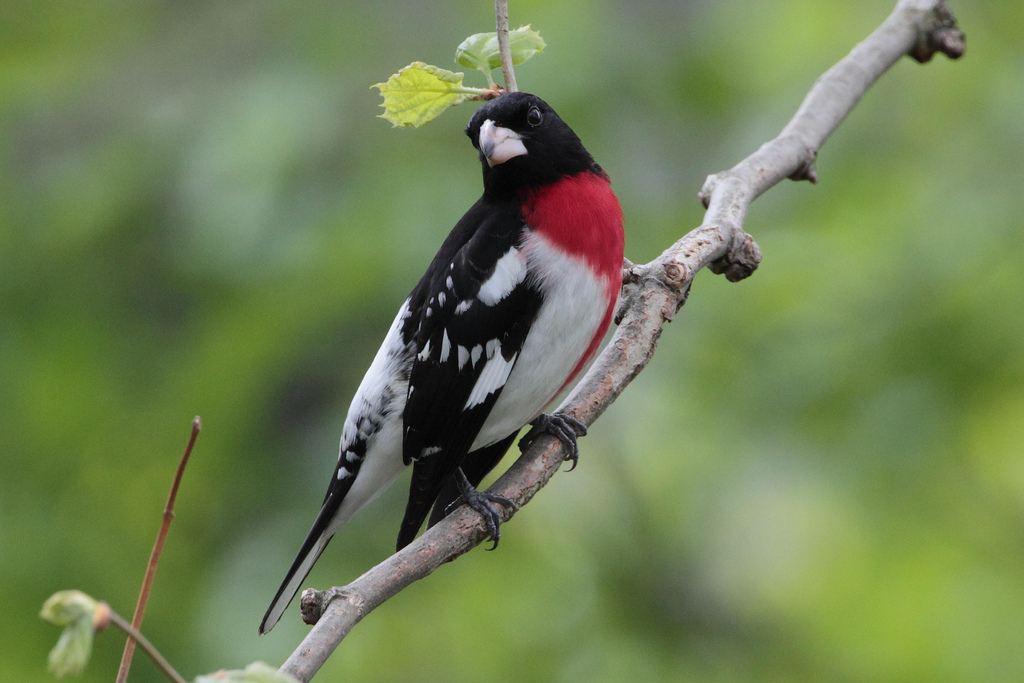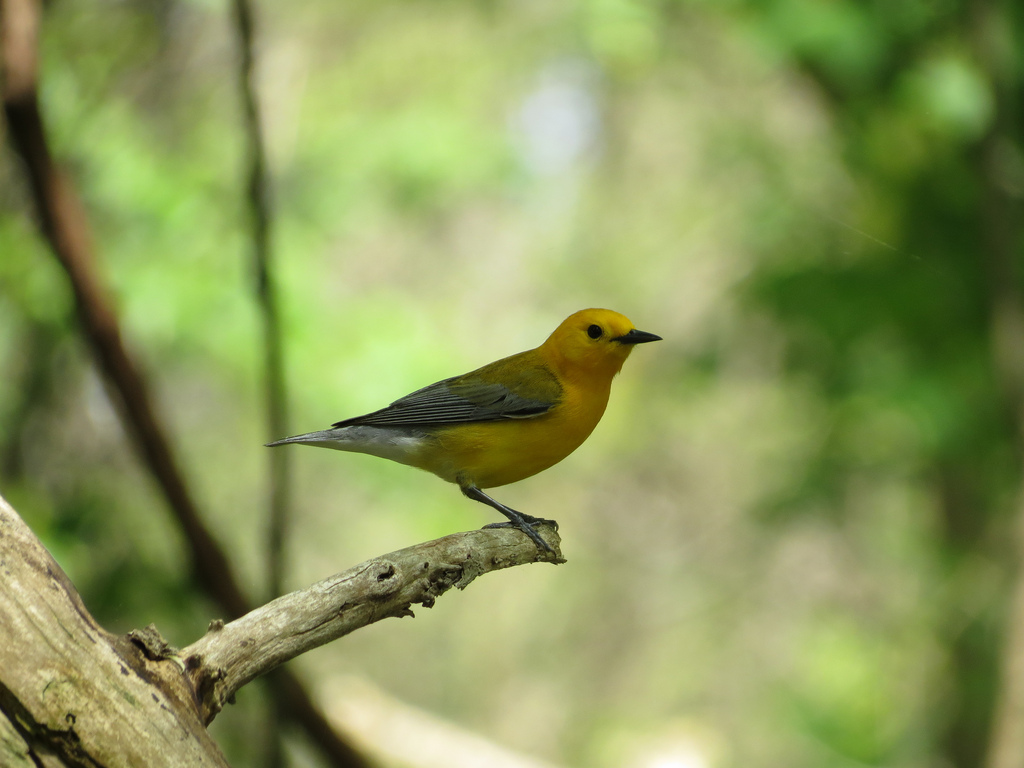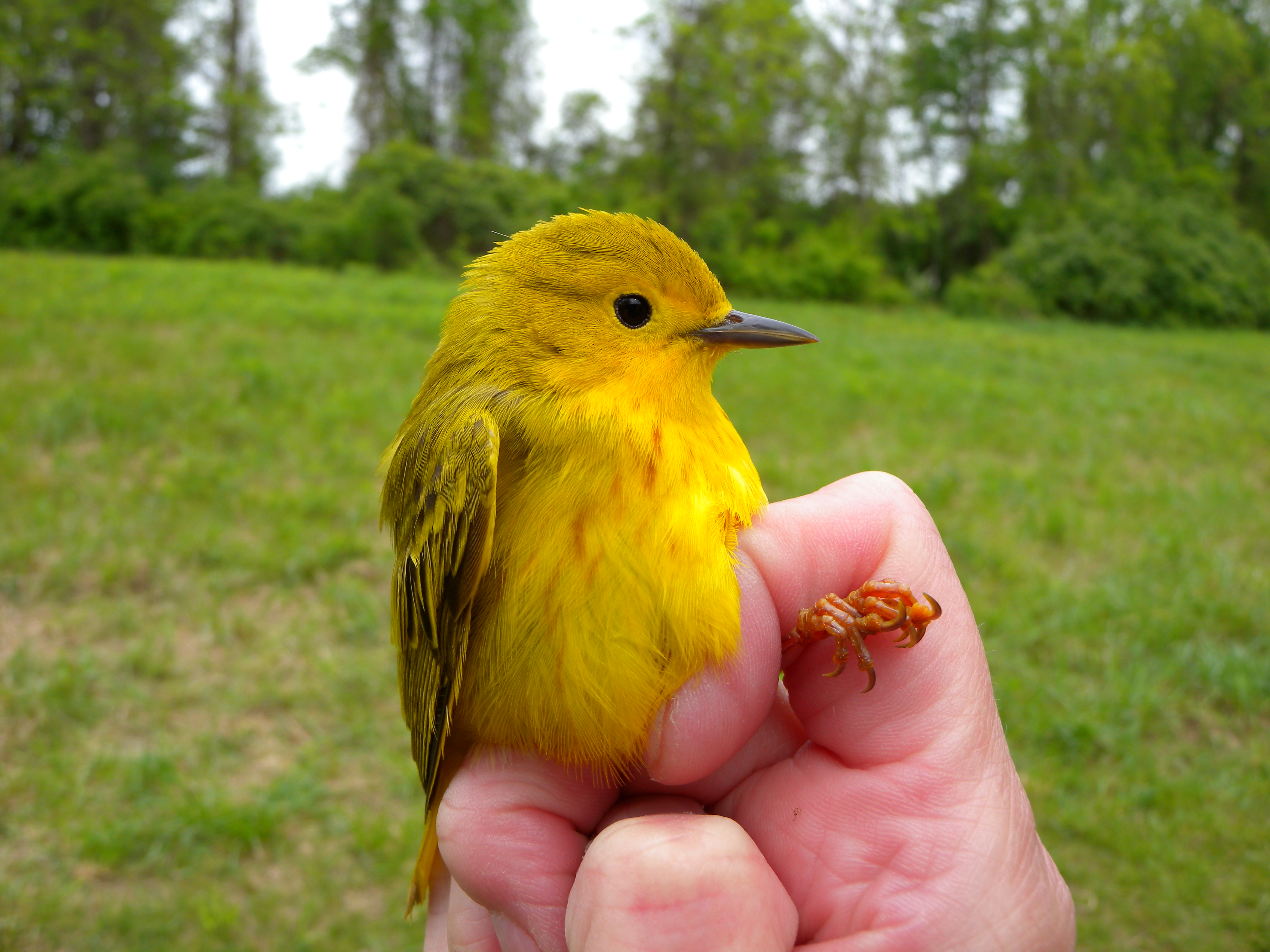
WAIT! If you’re a subscriber reading this in email format, before reading any further, please click on the title of the post right above in order to view the blog in the glory it was meant to have on the actual blog website.
___________________________________________________________
The last few May days of spring migration banding at Rushton were not spectacular in terms of numbers, but we did manage to add a few lovely first-of-the-year birds to our catch: a resident White-breasted Nuthatch, an Indigo Bunting here to stay for the summer, and a Northern Waterthrush passing through.

This spring, we caught just over 200 birds with 15 days of effort, which is quite a contrast from last spring’s bounty of 365 birds in 20 days. Adding extra days this spring would not have made up the difference because we were only catching about 8 birds a day, on most days. The coolness and abundant rain and storms of this spring seemed to somehow put a damper on the migration. There were very few nights with warm fronts from the south to encourage mass migration north, so the migration we saw seemed to me more of a slow trickle. This makes it hard to band any substantial number of birds, especially considering how often we got rained out of the banding station this spring.

Usually fall migration is better than spring at Rushton, with more individual birds and more species in the nets. This is probably because fall migration is generally more dire for birds; the threat of diminished food availability that comes with cold weather is a more immediate threat than the distant threat of getting your breeding territory overtaken before you get there in spring. Thus we see bigger flocks of mixed species touching down at Rushton during the fall rush. Fall at Rushton is also more nutritionally bountiful for the tired migrants. The shrubs in the hedgerows are loaded with berries, the meadows and farm fields have had more time to mature and the farmers even leave bruised or defective vegetables in the crop rows (which attracts insects for migrants).
PA Young Birders
The PA Young Birder Family Open House at the banding station on May 18th was an exciting educational experience for all. Adults and children had the chance to see first-hand why habitat conservation is so important as they viewed with wide eyes – and for the first time- the amazingly beautiful birds that travel right through their own backyards during migration. The survival of each of the birds they got to see up-close during the banding process depends on the availability of stopover sites, like Rushton, where they can rest and refuel before continuing their treacherous journeys. Some of the wonderful migrants we banded that morning included a Red-eyed Vireo, Gray-cheeked Thrush, Swainson’s Thrush and Wood Thrush.





On June 8, the Young Birders came out to Rushton for the annual “Kids Get Out and Bird” event. They learned about the importance of providing nest boxes for cavity-nesting birds, like bluebirds, as they helped gather monitoring data on each of Rushton’s bird boxes. After doing some birding in the woods where they got to hear the “weeping” of a Great -crested Flycatcher near the stream and the magical, flute-like serenade of the Wood Thrush, the children collected various botanical samples for leaf pressing!


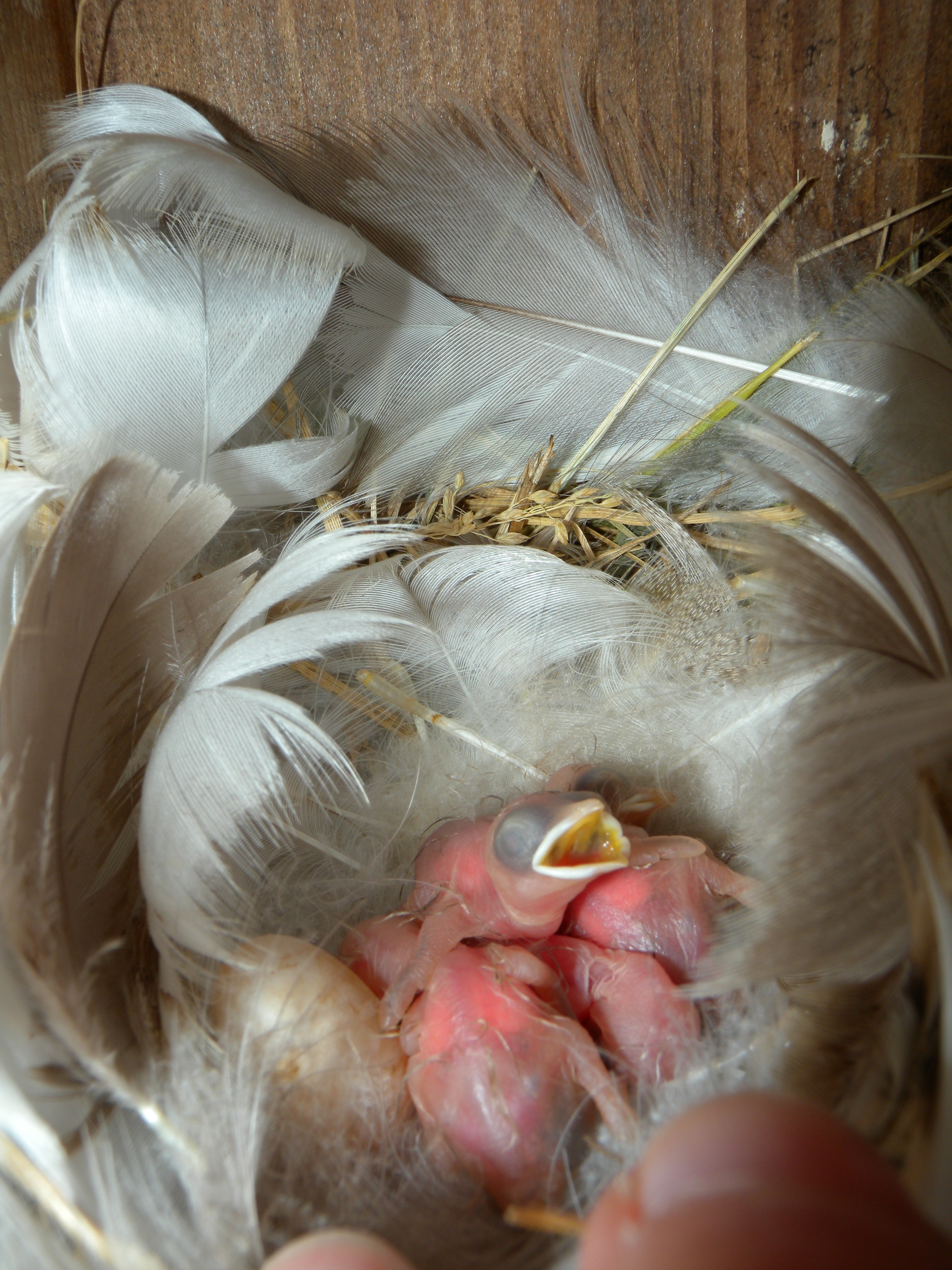



The Trust’s Junior Birder Club is a chapter of PA Young Birders , a club that invites kids to learn about the natural world while enjoying the outdoors and birding! Leaders include experienced birders and educators as well as guest experts and professionals. Some of our objectives are:
- To connect children to nature on an intimate level in order to foster a lifelong love of the natural world.
- To help children understand the interconnectedness of habitat, birds and other wildlife.
- To create in children a conservation ethic by demonstrating the importance of preserving open space.
- To develop children’s science skills and understanding of the scope of science.
- To refine children’s birding skills and cultivate a wholesome lifelong hobby.
- To give children the capacity and confidence to be stewards of the land on which birds depend.
- To nurture in children a spirit of discovery and wonder.
- To have children ultimately understand the positive role humans can play in the natural world.



Please let me (bhg@wctrust.org) know if you’d like to be included in our Junior Birder email list to receive invites to each of our programs and to receive the new schedule, which will be released this week. I’ve got a jam-packed schedule full of exciting events for the summer!
Upcoming PA Young Birders Program: “Sugartown Strawberries Purple Martins”
Wednesday July 3, 11:30am-1:30pm. Children AND adults, welcome!
On Wednesday, July 3, Farmer Bob has graciously invited us to visit his farm, Sugartown Strawberries, to meet his bustling colony of Purple Martins and watch the banding of the chicks! This is his fourth year being a proud Purple Martin landlord and his colony has been growing exponentially every year. He has over 50 chicks in his purple martin houses and gourds this year! These incredible insect-eating birds have become totally dependent on human-supplied housing for the summer and fly all the way to South America for the winter. Monitoring their conservation status is important, so we band Bob’s babies every summer when they are old enough. We will meet at the Willistown Conservation Trust office, 925 Providence Rd, Newtown Square PA (NOT RUSHTON FARM). Please let me know if you plan on attending this special opportunity (bhg@wctrust.org).


Young Birders Save the Date for the 2013 ABA Young Birder Conference -September 14!
The American Birding Association holds a Mid-Atlantic Young Birder Conference every fall at Ashland Nature Center, right in Hockessin, Delaware. It’s a wonderful opportunity for kids to learn about birds and build their birding skills under the guidance of well-known professionals in the world of ornithology and birding. More information can be found here : ABA Blog.
Exploring the Night Sky with John Black
Saturday July 6, 9:00-10:30 PM, at Rushton Farm. Families welcome.

Grab a blanket to lie on and binoculars or a telescope if you have one! Willistown has some of the darkest skies around the county, thanks to the Trust’s land preservation efforts. Come enjoy the dark, wish on a star and learn about astronomy from John Black, a Master Naturalist for Edwin B. Forsythe National Wildlife Refuge. Suggested donation : $10. Register with me (Blake Goll, bhg@wctrust.org).
Studying the Breeding Birds of Rushton Woods
It’s hard to believe we are in our third summer of MAPS banding. It seems like just yesterday we were trekking through the woods, setting up precise net locations and laboriously mapping the habitat diversity and structure of the woods to satisfy the rigorous scientific protocol for the Institute for Bird Populations (IBP).

MAPS, which stands for Monitoring Avian Productivity and Survivorship, holds the highest scientific standards of any banding project in which we can be involved. All of the data from about 500 MAPS banding stations in the country must be obtained from the same parameters in order for the Institute to be able to draw meaningful conclusions about bird population dynamics. This information is used to guide the U.S. Forest Service, Fish and Wildlife Service, National Park Service and other land managers in habitat management for birds.
We do not open our MAPS summer banding sessions to the public because the data recording is very serious, and we are there to monitor the breeding birds. Breeding birds are territorial and easily stressed, so we try to minimize the noise and impact to the area while we are banding. I’ll keep you updated on our findings through this blog, though! Otherwise, I encourage you to check out IBP’s website to learn more about MAPS and the other global projects they’re working on. The IBP also offers banding classes and internships all over the country, if you want to become a bird bander.
So far, this summer has been eerily slow in the woods. We band about once every 10 days and get a measly yield of 10-16 birds per 6 -hour session. The birds are there, but not in the abundance of previous years. Still, it’s uplifting to read the worn number of an old band on a Veery that we banded as a fledgling three summers ago. Holding these small fragile birds in my hand, it’s hard to believe that their little wings have carried them, more than once, all the way down to South America and back again to this patch of woods in Pennsylvania to breed.

All of the banded birds we catch during MAPS are birds that we banded in Rushton, either that year or a previous year. These are called recaptures, and they are exhibiting what is called site fidelity. Most birds return to the exact same breeding spot, use the same stopover sites during migration and overwinter in the same spot from year to year. As a result, we get to know some of our birds very well!

On the 4th of June, the elusive Kentucky Warbler that had been taunting us by broadcasting his rich “tur-dle” song from every corner of the woods, found himself tangled in one of our nets. Doris McGovern (federally licensed, Master Bander) extracted him, placed him gently in the bag and wordlessly handed the bag to me back at the banding table. It was the last bird of the day, and I just assumed it would be a catbird. I reached into the bag and as my hand came out with a strikingly bright yellow and black ball of feathers instead of gray, my eyes became saucers as I exclaimed, “Kentucky Warbler!” As if that weren’t exciting enough, the handsome fellow was sporting an old Rushton band from last summer! Man, were we thrilled to see him again! I’ll admit I even teared up a little.
We banded this special bird last summer as a young male in his second year, the very first Kentucky Warbler banded at Rushton (and still the only one). Now, he was as dashing as ever in his full adult plumage. He also had a cloacal protuberance (or CP), which is the male genital that becomes enlarged and round only during the breeding season to assist with mating and sperm storage. This means he was ready to mate, but it’s not a confirmation that he did. We are not optimistic that he ever found a female and settled in a territory because we kept hearing him singing from all different areas of the woods, as if he couldn’t seem to find what he was looking for. We’ve also never caught a female Kentucky Warbler to confirm a breeding pair. Who knows. Maybe she is just too smart to get caught in our nets, and he just has a very large territory.

The Kentucky Warbler loves low, moist, rich woodlands with luxuriant undergrowth and ravines. This is exactly what we have to offer at Rushton, which is significant because the species has been declining steadily throughout its entire U.S. range and is on the Audubon Watchlist. One reason for the warbler’s decline is degradation and in some cases complete loss of the understory vegetation due to browsing by an over-abundant White-tail Deer population. The understory of Rushton has been making a comeback in the past five years, ever since our deer hunting program has been controlling the herd there.

Visit Cornell’s “All About Birds” website to learn about any of our birds and to hear the Kentucky Warbler’s song, which is a confusing mix of Ovenbird and Carolina Wren, if you ask me. Also be sure to check out this preview of The Warbler Guide by Tom Stephenson & Scott Whittle, a highly anticipated book devoted entirely to our warblers that’s being released this month. It should be a great learning tool for all those interested in discovering more about the songs and life histories of the fascinating little warblers of our woods.
Other highlights of the MAPS banding season thus far were an Acadian Flycatcher and a bright yellow, adult female Scarlet Tanager in our nets! The Scarlet Tanager was quite a lovely surprise, considering they spend most of their time in the upper canopy and our nets are in the understory. Judging by the orange-ish hue on her face and back, we aged her as an older bird. Like some Kentucky Warblers, the Scarlet Tanagers spend their winters in the tropics of South America.

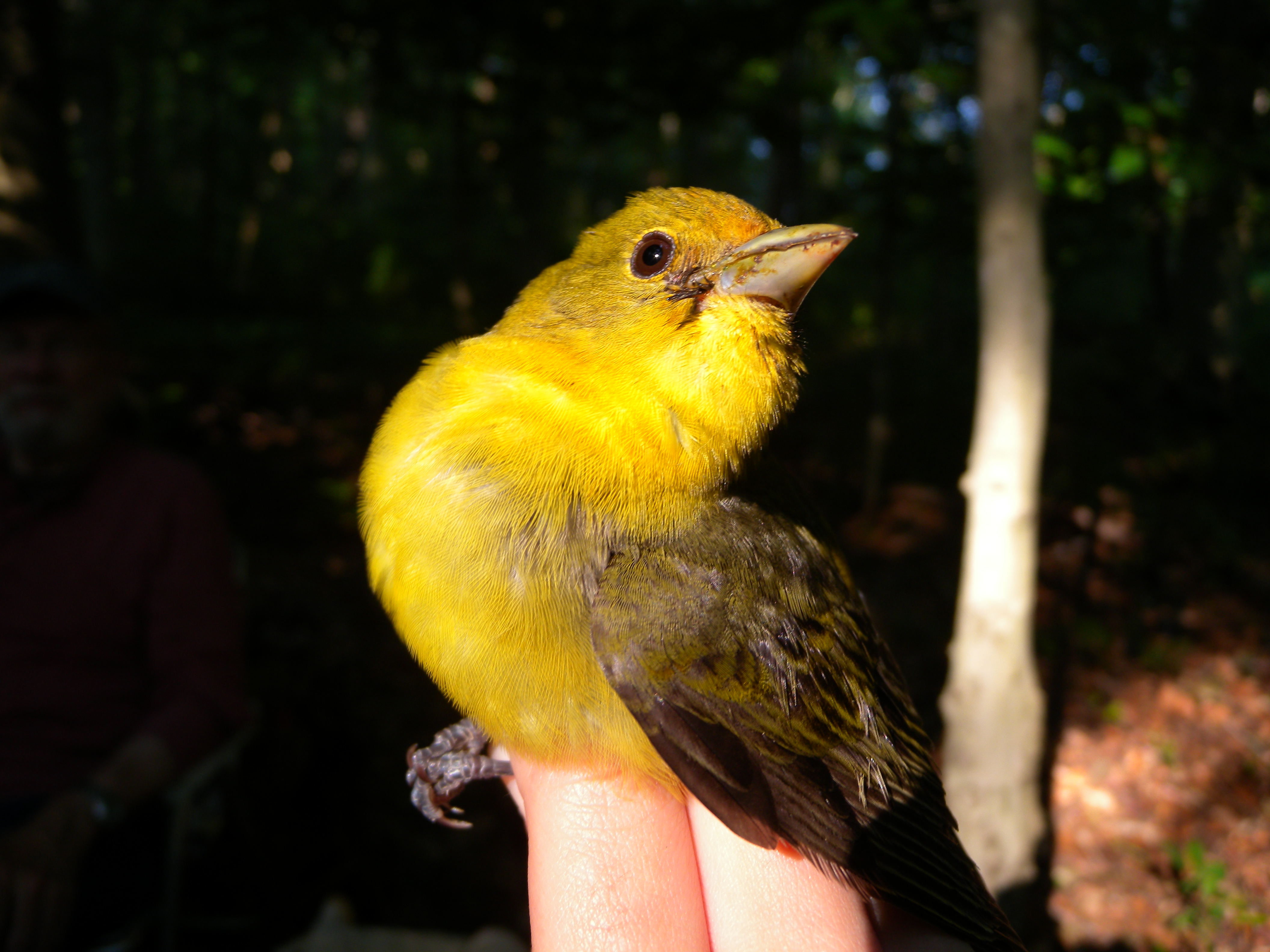


The male Scarlet Tanagers have been serenading us all summer, their tropical songs coarsely trickling down the leaves of the trees to our ears. Red-eyed Vireos’ clear notes soften the upper canopy chorus. The mid-story of the woods echoes with the ethereal flute-like songs of Wood Thrush and Veery, and the understory reverberates with emphatic Eastern Towhee songs, Common Yellowthroat broadcasts, intricate Gray Catbird music and the quirky sputtering melody of the White-eyed Vireo. Oven birds liven up the forest floor with their “Teacher! Teacher! Teacher!” calls.
The birds are certainly present, but we haven’t seen many juvenile birds yet, which should be the bulk of our catch now. We did band a precious juvenile female cardinal. Hopefully, more babies are to come. Below are pictures of some of the other adult breeding birds we’ve caught so far this season.





Other Bird Babies of Rushton
We have ten bluebird nestboxes sprinkled around the farm field area of Rushton, which we monitor weekly. We have had to remove a few dead chicks from the nest boxes; their deaths were most likely caused by the excessive amounts of rain that on some days prevented the parents from being able to find enough insects to feed the nestlings. Hypothermia is another threat to baby birds that get wet. This is one reason why monitoring nestboxes weekly is so important. It’s not ideal for the surviving chicks to continue growing in a box that has a decaying sibling in it. Morbid, I know, but this is nature.
Other than that, our nextboxes have been pumping out healthy baby birds left and right! We’ve had Tree Swallow, Eastern Bluebird, and House Wren chicks. Most have fledged and are now flying around the farm fields hunting the ample insects and keeping the farmers company as they harvest. After each “batch” fledged, we emptied out the old, dirty nest to make way for the new. Many of our birds have built new nests in the clean boxes and have started raising their second broods!



Rushton is certainly full of life right now. The unmowed natural meadows have burst forth with the exquisite flamboyance of victorian pink Common Milkweed flowers. Skippers, hairstreaks, fritillaries, azures, wood nymphs, sulphurs and swallowtails dance around the flowers like fairies at a ball. This is Act I of summer’s opulent show; to glance over this is to throw away wonders you’ll never know.



There’s a lot going on in the woods,
Blake



